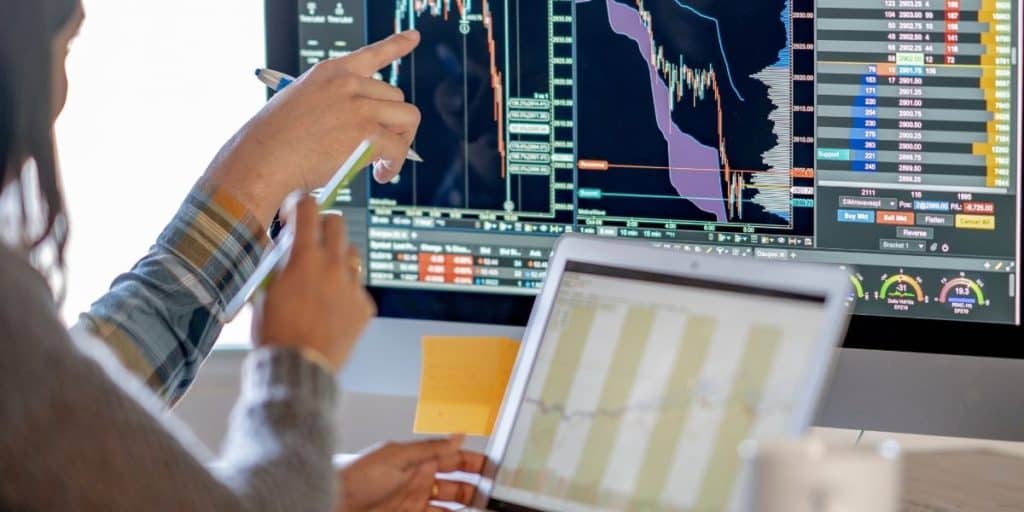Many people have a friend who likes to discuss the merits of day trading as a side hustle. They might talk about selling one profitable stock and using the money to buy two others at a lower-than-normal price just that morning. But could you also benefit from day trading?
Day trading can be a good side hustle if you have the time to watch price charts and spot new opportunities. Bots are popular because they can watch markets, even when you have to work a day job. But they usually aren’t very good at spotting breaking news that might affect stock prices.
Day trading may not be for people who are only looking for a side hustle. They may be better off investing in assets that can provide solid returns over time. If you’re considering day trading as a side hustle, the following information should help you decide.
IMPORTANT SIDENOTE: I surveyed 1500+ traders to understand how social trading impacted their trading outcomes. The results shocked my belief system! Read my latest article: ‘Exploring Social Trading: Community, Profit, and Collaboration’ for my in-depth findings through the data collected from this survey!
Table of Contents
What Is Day Trading?
Day trading involves buying an asset and then selling it again in less than a day. Day traders typically make use of the foreign exchange (forex) and stock markets. It’s typical for them to use leverage and short-term trading techniques to complete their trades.

Those who do it for a living can get a good feel for when an asset is about to move and use several tools to keep track of assets they might be interested in trading. For the most part, day traders will keep track of several variables that can generate even the slightest short-term price movements in the assets they trade most often.
A day trader’s tools include price charts, which they’ll usually set to the smallest possible time increments to get a better look at short-term price moves. However, some strategies do require the use of tools outside of the price charts.
4 Commonly Used Day Trading Strategies
Experienced day traders will make use of a few basic strategies to make their trades. These include:
- Scalping: This takes advantage of small price moves throughout the day. This strategy works on the same principle as ticket scalping at big-name sporting events. In other words, the scalper will buy surplus tickets for less than the retail price and then sell it to others who are willing to pay the retail price to attend the event.
- Range Trading: This relies on the tracking of support and resistance levels to make their trades. It requires a good feel of the most likely price range in which a stock will move.
- News-Based Trading: This can be one of the most solid strategies because it takes advantage of actual news that impacts an industry or a single company. Perhaps a company released a quarterly report that was better than expected or acquired another, solidly performing company, which can cause the stock to go up. Or the company had dismal reports recently or had to file for bankruptcy, which will cause the stock to tank.
- High-Frequency Trading: This strategy most frequently uses bots that can crawl markets, looking for opportunities that match the bot’s user criteria. They often seek out short-term market inefficiencies so that they can profit from a rapid series of trades.
Why Day Trading Isn’t the Perfect Side Hustle?
One common perception of day trading is that it is a “get rich quick” scheme. In the past, scammers have reached out to beginners, promising quick profits. Many beginners have unwittingly joined illegal “pump and dump” groups and gotten burned.
If you intend to day trade as a side hustle, you can and will miss opportunities that an experienced full-time day trader would’ve spotted. Your day job will eventually get in the way. So, unless you can find a good trading bot to trade on your behalf, you’ll have to put up with lower returns than full-time day traders make.
Professional day traders will have access to sophisticated high-end tools like technical analytics programs, newsfeeds, price tickers, and headline tickers. They’ll also use sophisticated bots to keep track of at least some of these variables, especially if they use easily parsed numbers. You may not have access to these tools unless you’re willing to pay some money upfront for them.
Even full-time day traders will have lower returns than those who prefer to build a portfolio of long-term holdings. The constant buying and selling of assets can make it challenging to realize the long-term gains that solidly performing stocks can bring. They would have missed out on the 740% gains that Tesla stock made in 2020 because they wouldn’t hold the stock long enough, for instance.
Be Aware of Risks and Fees
Becoming too attached to a particular asset may be a risk for novice day traders. This is particularly a concern when trading certain asset classes like cryptocurrencies, in which newsfeed bots may turn up a lot of social media chatter from people who have let themselves become too invested in a particular cryptocurrency or digital token. People who fell into this trap lost a lot of money when the Bitconnect Ponzi scheme collapsed, for instance.
Taxes and fees should also be taken into consideration when day trading. Etrade charges clients that make at least 30 trades per quarter $4.95 per trade. You’ll also have to pay taxes on your capital gains from trading. Both of these variables will inevitably reduce your profits from day trading.
The Positive Aspects of Day Trading
Day trading can be a reasonably profitable venture if you have a solid strategy and stick to it. You may want to find an online “sandbox” that allows you to refine your methods without putting your own money at risk. Then you can get a good idea of what works and what doesn’t.
Part-time day trading is most useful for people who feel comfortable taking risks with their money. They know how to be patient and disciplined enough to stick to the plan even when everybody else is falling victim to temptations like “Fear Of Missing Out” or “Fear, Uncertainty, Doubt.”
Many people who do it as a side hustle are doing it to pay bills or save up for a luxury purchase and recognize that delayed gratification is preferable to losing a lot of money on an exceptionally risky trade.
Some part-time day traders will speak of the satisfaction of making a few highly successful trades when they talk about their trading at all. While they may only complain about their losing trades after they’ve had a few beers, it can be quite a good feeling to have made a respectable profit before you’ve even started your shift at your day job.
Day trading might be a good side hustle, but it’s rare for part-time day traders to get rich doing it, and you can lose a lot of money doing it if you aren’t willing to put in the work to develop a solid plan. The most experienced full-time traders are most likely to earn a meaningful profit doing it and usually have been in the business long enough to have a keen understanding of the markets. Even they can — and often do — lose out in a bad trade.
Author’s Recommendations: Top Trading and Investment Resources To Consider
Before concluding this article, I wanted to share few trading and investment resources that I have vetted, with the help of 50+ consistently profitable traders, for you. I am confident that you will greatly benefit in your trading journey by considering one or more of these resources.
- Roadmap to Becoming a Consistently Profitable Trader: I surveyed 5000+ traders (and interviewed 50+ profitable traders) to create the best possible step by step trading guide for you. Read my article: ‘7 Proven Steps To Profitable Trading’ to learn about my findings from surveying 5000+ traders, and to learn how these learnings can be leveraged to your advantage.
- Best Broker For Trading Success: I reviewed 15+ brokers and discussed my findings with 50+ consistently profitable traders. Post all that assessment, the best all round broker that our collective minds picked was M1 Finance. If you are looking to open a brokerage account, choose M1 Finance. You just cannot go wrong with it! Click Here To Sign Up for M1 Finance Today!
- Best Trading Courses You Can Take For Free (or at extremely low cost): I reviewed 30+ trading courses to recommend you the best resource, and found Trading Strategies in Emerging Markets Specialization on Coursera to beat every other course on the market. Plus, if you complete this course within 7 days, it will cost you nothing and will be absolutely free! Click Here To Sign Up Today! (If you don’t find this course valuable, you can cancel anytime within the 7 days trial period and pay nothing.)
- Best Passive Investment Platform For Exponential (Potentially) Returns: By enabling passive investments into a Bitcoin ETF, Acorns gives you the best opportunity to make exponential returns on your passive investments. Plus, Acorns is currently offering a $15 bonus for simply singing up to their platform – so that is one opportunity you don’t want to miss! (assuming you are interested in this platform). Click Here To Get $15 Bonus By Signing Up For Acorns Today! (It will take you less than 5 mins to sign up, and it is totally worth it.)

Conclusion
The reality is that many people who might have tried to jump straight into day trading as a side hustle will give up after a few bad trades. If you don’t feel comfortable taking risks with your money or don’t want to take the time to develop your strategy, you might be better off choosing another side gig that involves less risk or the need for sophisticated strategies.
BEFORE YOU GO: Don’t forget to check out my latest article – ‘Exploring Social Trading: Community, Profit, and Collaboration’. I surveyed 1500+ traders to identify the impact social trading can have on your trading performance, and shared all my findings in this article. No matter where you are in your trading journey today, I am confident that you will find this article helpful!
Affiliate Disclosure: We participate in several affiliate programs and may be compensated if you make a purchase using our referral link, at no additional cost to you. You can, however, trust the integrity of our recommendation. Affiliate programs exist even for products that we are not recommending. We only choose to recommend you the products that we actually believe in.
